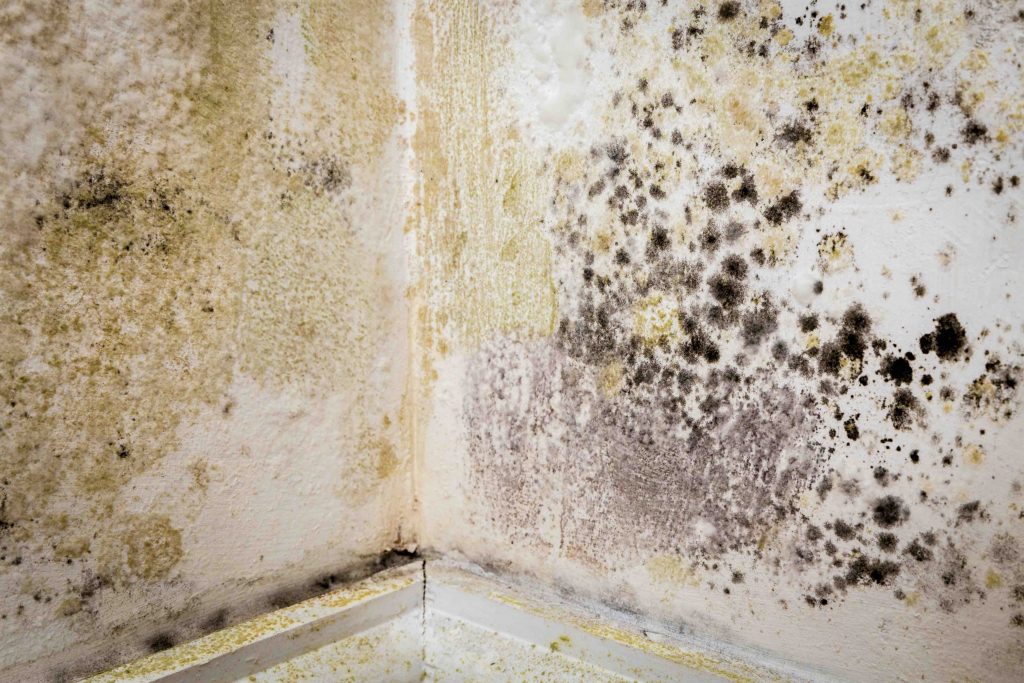
Mould.
It’s a fairly common complaint here in the UK. Chances are you’ve come across it somewhere in your home, school or work.
The four conditions mould requires to grow are organic matter, oxygen, warmth and moisture.
Thanks to the UK’s inclement climate – particularly during the winter months – it can mean that mould becomes particularly prevalent.
But what are the health and safety risks associated with damp and mould?
In this blog, we’ll take a look at the potential dangers to both properties and humans.
Mould And Structural Damage
Let’s first examine the potential structural problems that mould can cause to buildings.
Mould consumes organic materials such as wood, paper and natural garments. If mould is not treated, it can ultimately cause substantial damage to properties.
Here are some of the most common issues.
Dry rot
Dry rot is a severe issue usually found in rooms with poor ventilation.
Once it sets in, it can spread rapidly.
There are several tell-tale signs, including:
- A damp, mushroom-like smell
- Any exposed, dry timber which crumbles between the fingers
- Fine, grey cobweb-like strands growing on timber
- The presence of Mycelium (which looks like cotton wool) or red/orange mushroom-like fruiting bodies.
Although it feeds on organic matter like moisture in wood, it can also grow through bricks and mortar, which makes it the rot that strikes the most fear into property owners.
For this reason, if you suspect or find any evidence of dry rot in a building, it is highly recommended that you call a professional to investigate.
Left untreated, dry rot can be a real threat to a property’s structural integrity.
Our experts would be able to remove any moisture sources and dry the affected area rapidly. All rotted wood would then need to be removed and replacement timbers treated with preservatives.
To avoid the problem arising again, ventilation pathways would need to be introduced before adding a damp-proof membrane or joist hangers between timber and wet brickwork.
Wet Rot
‘Wet rot’ is the common term used to describe many common wood-destroying fungi. The term is used becasue of the appearance of the affected timber (looking wet).
Typical indications of wet rot include:
• Bleaching or darkening wood
• Cracking timber
• Timber that’s distorted and losing its strength
• Fungal growth
Understanding the cause of the wet rot is vital before any remediation can begin. Professionals should do this because the possible sources of moisture causing the wet rot could be endless.
Once the cause and extent of the damage have been established, damaged timber will need to be removed and replaced with pre-treated wood.
In some circumstances, wet timber that is still strong can be protected using timber preservatives.
Again, professionals will be able to advise the best solutions to help save the building from future structural threats.
Roof leaks
One thing we know about living in the UK is that it rains. A lot.
And as a result, it is not uncommon to see roof leaks. These can lead to mould feeding off the moisture that develops in humid rooms.
Once you have identified a leak in your property, it is vital to have it dealt with quickly to prevent further damage.
Left untreated, condensation and rainwater could cause the rot of any organic materials (such as wooden floorboards and roof joists), causing expensive problems and potential associated issues with health.
Professional contractors can stop the leak and prevent further water damage.
HVAC system
HVAC systems in commercial and residential properties can sometimes fall prey to mould, particularly if they get blocked.
Regular servicing will help prevent this.
But if fungi are found, they can be spread very quickly throughout the HVAC system. That won’t be good news for anyone working or living in the building (more on potential health issues below).
Professional mould cleaners can get to the source of the issue and remedy it efficiently.
Furniture and personal property damage
Mould spores can be tough to remove from fabric found in furniture and clothing.
Sometimes, personal belongings have to be thrown out.
These spores can be tough to spot, so checking your home consistently for any signs of mould is essential.
Mould And Health Risks
So, we have looked at the physical issues that mould can cause to buildings.
But what about the potential health risks it can cause to humans and animals?
Both the WHO and the NHS agree that mould exposure can cause an increased risk of experiencing respiratory symptoms, infections, allergic rhinitis and asthma.
Other common symptoms of mould can include:
- Coughing
- Sneezing
- Constant tiredness
- Eye and throat irritation
- Headaches
- Skin irritation and rashes
- Nausea
- Chest tightness/difficulty breathing
- Nosebleeds
Mould and mental health
We have looked at some of the physical health issues that mould can have, but it can also impact people’s mental health.
Living and/or working in mouldy conditions can be very stressful.
The damage can look unappealing, personal possessions may have to be destroyed, and of course, there’s the worry about the impact on your health.
Vinci’s Mould Remediation Services
As we have seen, the impact of mould can be severe and widespread.
If you have recently experienced moisture-related issues, a flood or a water leak in your property and are concerned about the appearance of mould, contact us today.
Our technicians have vast knowledge and experience in dealing with mould remediation and are fully compliant.
They will carry out the mould remediation with the full required personal protection equipment (PPE) to ensure your building is kept safe and there is no cross-contamination.
Contact our mould remediation team for a no-obligation estimate and to arrange your site survey.